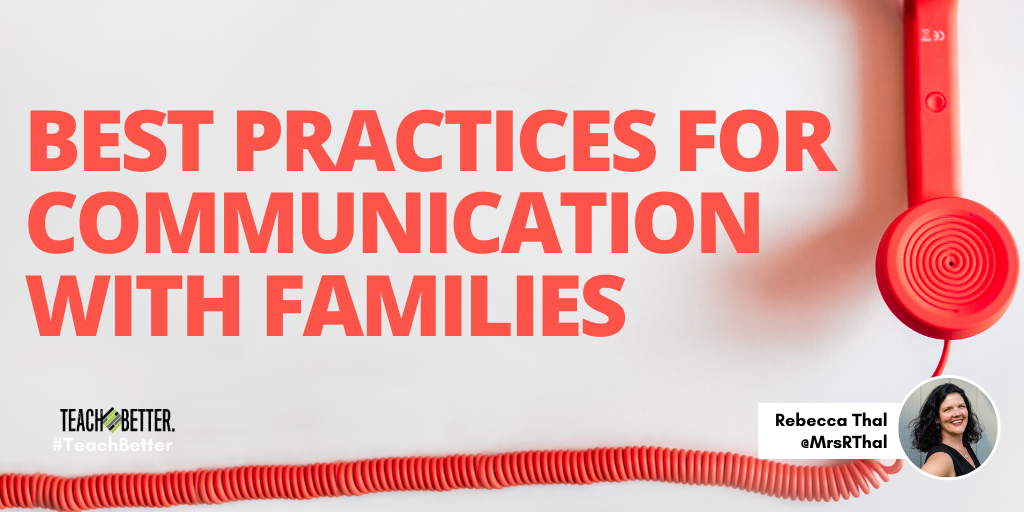TL;DR:
- Strategies for best communication practices, including being proactive, making time for what’s important, keeping it simple, and being consistent.
- Using ClassDojo, ClassTag, SeeSaw, Remind, emails, phone calls, notes, postcards, and social media as tools to communicate and stay connected with families.
Now more than ever, parents and teachers need to work as a team for the benefit of our children. As it becomes more apparent that some type of remote learning will be a reality again next year, we need to focus on ways to keep families in the loop.
A common complaint I heard during this past spring was that many folks had no idea what their children were doing online or what they were expected to do. This was especially true for the older children who were more tech savvy. They didn’t need their parents’ help navigating online assignments and most were left to their own devices.
The only communication many parents received were emails or calls from teachers stating that assignments were missing or incomplete, or that their child had not logged on in several days/weeks. Admittedly, the first several weeks and even months of remote teaching were very much a trial and error period.
Reflecting back on what worked and didn’t work regarding parent and student communication can help us game plan better as we move forward.
Students need to see that their parents and teachers are working together as a team. By getting on same page early on, you ensure you will be able to navigate whatever the school year has in store - together. Click To TweetCommunicating with Families: Make time for what’s important.
I’ll be the first to tell you that I was never big on reaching out to families just to say hi or share something positive. It wasn’t because I didn’t see the value – I just couldn’t seem to find the time. However, if this whole pandemic has taught me anything, it’s that you need to MAKE the time for things that are important.
When I started communicating more with families during remote instruction, they were very appreciative. Now, as I look forward to a new school year, I realize that building relationships with students and families early on will be more crucial than ever. I also realize it will benefit everyone if I take a more proactive approach from the get-go.
Communicating with Families: Be proactive.
So why do I say proactive? Well, let me start by saying I was totally caught off guard when I received a call from my daughter’s 2nd grade teacher last August. I immediately thought something was wrong (and we hadn’t even started school yet)! Unfortunately that’s how we, as parents, have been “trained” to think. If you get a call from a teacher or administrator it must be bad (reactive).
However, she was simply calling to introduce herself and tell me how she was looking forward to meeting Sarah. I hung up in shock and thought what an awesome proactive thing that was to do! It really stuck with me. If we work to develop positive relationships with families first, then when we have to address a situation or problem later, it will hopefully be received better.
Communicating with Families: There are many options.
Shortly after school started last year, that same 2nd grade teacher sent home codes for me to stay connected to her and the class on ClassDojo and Seesaw. Both are pretty awesome platforms for very different reasons. I liked seeing my daughter’s work on Seesaw so much that I ended up creating my own teacher account. This turned out to be a lifesaver during remote instruction!

Photo by John Schnobrich on Unsplash
I personally was using ClassTag this past year to communicate with my families, sending weekly or bimonthly updates during remote instruction. My sons’ teachers were sending a lot of information through Remind (I have also used this in the past). Commonsense.org has a list of messaging apps and websites you can take a look before deciding which is right for you.
I have found that it usually takes several months before deciding if one app or website is better than another. Sometimes you need to see how you utilize it over the course of a whole year. Also ask your colleagues, as well as the parents themselves, for feedback. I personally have never wanted to switch to a different app mid-year because I was worried about causing confusion.
Among all of the choices that are available for apps and websites, it depends on what you’re looking for. Some teachers may want to keep things simple, while others like to videotape messages and share them out. Some like to have their students build online portfolios. I, myself, have found that inviting parents to follow me on Twitter and Instagram has been a big plus. Folks love to see pictures of their kids in the classroom! I even created a classroom job – “Social Media Assistant” – where I give one student each week the opportunity to help me create posts for my accounts (thanks to the book Kids Deserve It! for this awesome idea).
Keep it simple.
If you are in an area where access to technology is inconsistent, there are equity issues, or you just find yourself on technology overload, you can always keep communication simple. Emails, phone calls, notes, and postcards home will still do the job to help everyone stay connected. Some parents who are not tech savvy may prefer a more traditional form of communication.
Be flexible and be prepared to have to customize things a bit. This may also be true if you have families where English is not their primary language. Your message itself also doesn’t need to be complicated. A simple “check in” or a message home with some good news to share goes a long way.
[scroll down to keep reading]
Consistency is key.
The most important things to remember when communicating with parents is to be consistent. Keep in touch on a regular basis – both in good times and in bad. Invite them into your classroom – without actually inviting them in! Try to look at things through the lens of a parent, and not just as a teacher. Be open, honest, and flexible, while setting clear expectations for maintaining communication.
Taking steps to build relationships as the next school year approaches will guarantee a smoother transition for everyone. Students need to see that their parents and teachers are working together as a team. By getting on same page early on, you ensure you will be able to navigate whatever the school year has in store – together.
ABOUT BECKY THAL
Becky Thal is a 5th grade math and science teacher in New Jersey and a Data Analyst for the Teach Better Team. Prior to starting her career in teaching in 2005, Becky worked for several years in advertising in New York City. She is an active member of her school staff, currently serving on several committees including SEL, Climate and Culture, and the Future Ready Team. Becky is also an active member of her community and her children’s schools. In her spare time, she enjoys trips to the beach, trying new restaurants, and attending her kids’ various games and events . Becky lives with her husband, three children and dog, Cliff, who she loves spending time with on the weekends.



